
October 2020 Volunteer Spotlight — VBSPCA Employees
There are thousands of cats, dogs, and small animals that go through our foster program each year. These animals have medical issues, are too young to be in the shelter environment or need additional love and care. Our amazing fosters step in to provide that care, and some of these people are also employees who freely give their time away from the shelter to help special cases. Four of our employees who are also dedicated fosters shared why they love fostering. Read their reasons why below!
Ashley —
I started fostering animals when I was in college and it has added so much to my life. Looking for a new shelter to foster for after graduation is actually what led me to finding my job here. I went to the VBSPCA website looking to give a temporary home to some animals but I ended up finding a new home for myself. Of course I still foster, and it has put me in an incredibly unique position. The animals I foster all eventually go back to the shelter to find their forever homes. The time they spend with me allows me to get to know them more than I ever could in the shelter environment; so when it comes time to find their families, I can tell potential adopters so much more about each animal and help them find their perfect match.
I have loved every one of the animals that have come through my door, but this litter of kittens and their momma is by far the most entertaining. Having six extra cats in my house is absolutely a lot of work, but I am lucky to have my parents at home who not only put up with me bringing all kinds of animals back from work, but are happy to step in for a feeding, scoop a litter box, or walk a dog.
Sydney —
 Marshmallow is a dog that will hold a special place in my heart for the rest of my life. He came to our shelter extremely shut down and scared. He stayed in the corner of the cage and would sometimes growl at kennel staff when they tried to handle him. I started sitting with him each day to let him know he was in a safe space with good people, and once he was comfortable, I brought him into my office to get a break from the other dogs. He was still having issues with stress, so I began to take him home on the weekends to prepare him for adoption and his new home. My young daughter and him immediately bonded, and he loved curling up around her while she played with a toy or flipped through a book. But by far his favorite spot in my home was my closet, where he would scoot himself in between my clothes and shoes. Not the easiest feat for a 65 pound dog! Through this fostering experience, Marshmallow slowly regained his confidence and became the dog I always knew he had the potential to be. He was adopted by a wonderful family and I will always be grateful I was able to be part of his story. Fostering Marshmallow proved to me how rewarding it is to open up your home to animals that are in need of a little extra patience and love.
Marshmallow is a dog that will hold a special place in my heart for the rest of my life. He came to our shelter extremely shut down and scared. He stayed in the corner of the cage and would sometimes growl at kennel staff when they tried to handle him. I started sitting with him each day to let him know he was in a safe space with good people, and once he was comfortable, I brought him into my office to get a break from the other dogs. He was still having issues with stress, so I began to take him home on the weekends to prepare him for adoption and his new home. My young daughter and him immediately bonded, and he loved curling up around her while she played with a toy or flipped through a book. But by far his favorite spot in my home was my closet, where he would scoot himself in between my clothes and shoes. Not the easiest feat for a 65 pound dog! Through this fostering experience, Marshmallow slowly regained his confidence and became the dog I always knew he had the potential to be. He was adopted by a wonderful family and I will always be grateful I was able to be part of his story. Fostering Marshmallow proved to me how rewarding it is to open up your home to animals that are in need of a little extra patience and love.
Kate —
Fostering small animals was not something I anticipated doing, but I have now fallen in love with nurturing these amazing animals. My first experience fostering a small animal started when a couple walked into the shelter with mom and seven newborn mice. I’ve had mice in the past so I couldn’t say no. Three weeks later the mom, who I named Jennifer, unexpectedly gave birth to her second litter of 10! Thankfully she is a rock star and nursed them all. The hardest part was determining the gender of the pups early enough to make sure our shelter did not end up with more unexpected litters. While I was fostering both litters, it was so rewarding to watch them grow and become independent. After all the mice were successfully returned to the shelter, I adopted Jennifer, and she is now living her best life with no more pregnancies!
Kory —
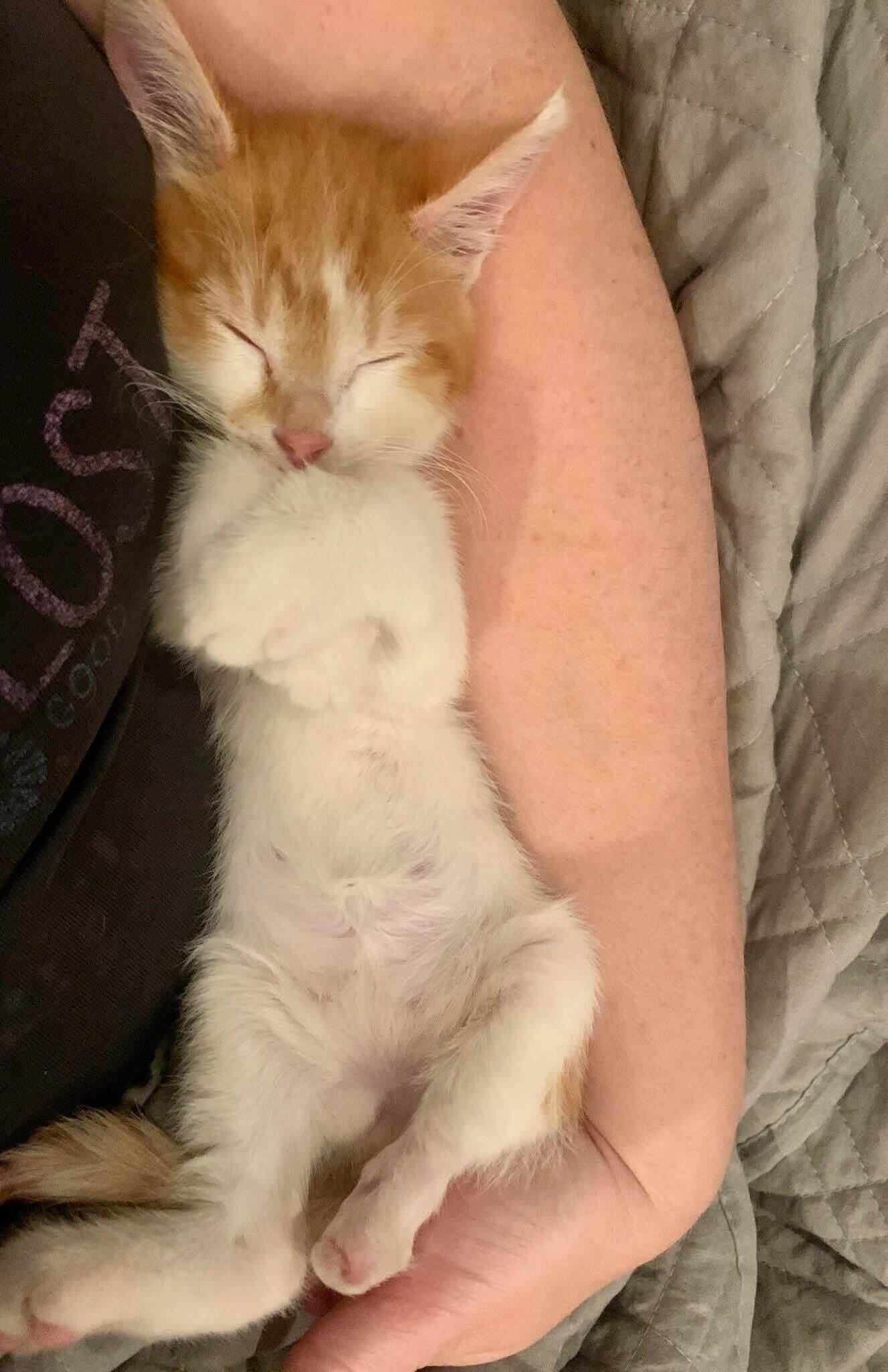 As the lead vet assistant at the VBSPCA Clinic, I see almost all of the sweet animals that come through the doors of the VBSPCA. Many are happy and healthy, ready for their new forever home, but some are depressed, stressed, sick, or hurt. I have a soft spot for those. Those animals need extra love, extra care, or a quiet place to heal. Fostering is so important for these animals. Kittens like Captain, who was found in a warehouse, all by himself, missing a foot. He was hurting and his wounds were open and infected. Luckily he was brought to us and we immediately cleaned and wrapped his leg and then started him on antibiotics. For the last 5 weeks, he has been living in my home with my two cats who are teaching him how to play and be a great kitten! Without his daily medication, bandage changes, and a quiet, loving, safe home, he would not have healed as well as he did. Captain will be ready for adoption soon and will make a great addition to his forever family!
As the lead vet assistant at the VBSPCA Clinic, I see almost all of the sweet animals that come through the doors of the VBSPCA. Many are happy and healthy, ready for their new forever home, but some are depressed, stressed, sick, or hurt. I have a soft spot for those. Those animals need extra love, extra care, or a quiet place to heal. Fostering is so important for these animals. Kittens like Captain, who was found in a warehouse, all by himself, missing a foot. He was hurting and his wounds were open and infected. Luckily he was brought to us and we immediately cleaned and wrapped his leg and then started him on antibiotics. For the last 5 weeks, he has been living in my home with my two cats who are teaching him how to play and be a great kitten! Without his daily medication, bandage changes, and a quiet, loving, safe home, he would not have healed as well as he did. Captain will be ready for adoption soon and will make a great addition to his forever family!
If you would like to get involved with our foster program, please email us at foster@vbspca.com.
Mind and Body — How to Help Your Pet Stay Fit
Fitness is vital to the health of all pets. Physical fitness prevents obesity while strengthening muscles and bones, but there is more to being fit than just strengthening the body… the brain needs to be fit, too. Both physical and mental stimulation are essential to being a responsible pet parent. Among many other benefits, mental and physical fitness reduce the risk of disease and increase longevity which will help you and your furry friend live a long, happy life together. Read below for more information on how you can provide your pet with the keys to wellness, and make sure to download the infographic to share with other pet parents in your community.
Fitness and The Brain:
Pet fitness is the foundation of a well-rounded pet. Exercising the brain affects health by releasing feel-good endorphins into your pet’s system to help their body work smoothly. And of course, if they feel better, then their overall behavior is better.
However, what happens when the behavior is destructive? While this is a common complaint among pet owners, what you may not realize is that your pet may be trying to communicate their boredom. Patterson cautioned that If your pet is being destructive or showing signs of stress, this may be a sign that you need to give your pet more variety in the area of mental stimulation.
Exercise and mental health go hand in hand for mammals, similar to how it is with humans. It is important to remember that the brain is also a muscle and performs better when it is fit. Read below to learn how you can ensure that your pet has the tools and play needed to exercise both their brain and body.
Let’s Work Out!
Dogs:
Dogs require exercise and mental stimulation so they can be on their best behavior. Canines are also social animals, so working out with a buddy is recommended. Here are a few ideas to get you and your pup started:
- Make mealtimes fun by buying a puzzle feeder or creating your own by using a paper bag. This helps your dog use their olfactory senses to problem-solve their way to a yummy treat!
- Taking a different route than usual for your daily walk. This helps dogs build their confidence in new surroundings and also allows curious canines to discover different sights and smells.
- Teach them a new trick. This counts as both exercise and mental stimulation. Training is one of the best things you can do for a dog’s wellbeing, as it helps prevent boredom and works in your favor to improve obedience. Both you and your pup will feel accomplished after a successful training session.
- Going for a run helps build the bond between you and your dog, while also being a great form of exercise. If you think running would be a great activity for you and your pet, click here for some helpful tips.
Cats:
Contrary to popular belief, cats need as much physical activity and mental stimulation as dogs! However, all of this can be done from the comfort of your own home. Felines are natural hunters and enjoy activities such as:
- Puzzle feeders, which help your cat’s problem-solving skills. Cats love to stretch their claws, so for added physical activity, cut a hole in a small cardboard container and hang it above the ground to encourage jumping and swatting.
- Chasing a laser or lure toy builds your cat’s confidence and is also a great form of exercise. Try to play with your cat for at least 10-15 minutes. If your cat seems disinterested or bored, it may be a sign that it is time to rotate toys.
- Teach your cat a trick or two! Clicker training is one of the best ways to help your cat stay healthy and confident. Click here for some helpful training tips.
Rabbits and Guinea Pigs:
Small animals are intelligent and constantly on the move. Animals like rabbits and guinea pigs have a lot of excess energy that they need to burn in order to be happy and healthy pets. Some creative ways to help prevent boredom and destructive behavior are:
- Stuffing cardboard rolls with hay or another healthy treat is a perfect way to encourage appropriate chewing while also giving them a fun puzzle to figure out!
- Creating a DIY obstacle course to exercise your small animal’s mind. Both rabbits and guinea pigs are curious and love to discover new things. Use boxes or pillows to build your pet a maze, and you can create barriers that they will have to get around for added mental stimulation. Have their favorite food or treat waiting for them at the finish for a reward.
- Supervised exercise outside their pen. Small animals like rabbits and guinea pigs need time outside their cage to explore the world around them. Make sure to stay with them at all times, and for added fun, place their toys around the area so they have approved items that they can chew on.
Download the infographic below for a helpful reminder to help your pets stay active!
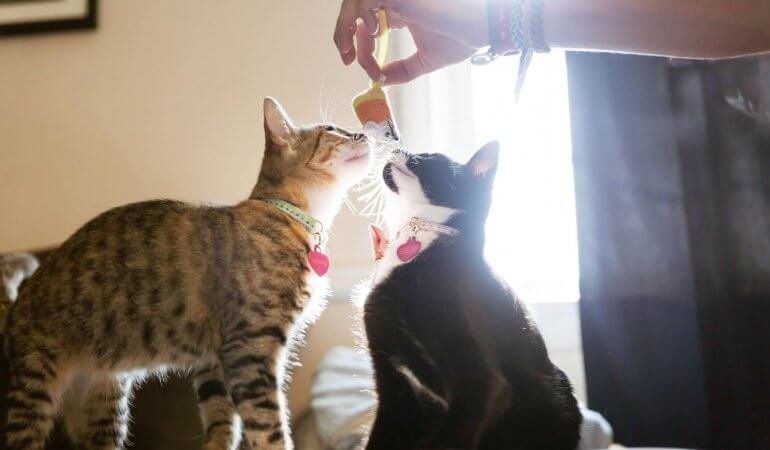
Happy Tails — Ginny and Wanda
Every single animal that comes through our shelter has a story. Some are complex, many are sad, but all of them get better the minute they arrive at the Virginia Beach SPCA. Ginny and Wanda arrived at the VBSPCA as kittens in need of a loving foster home. After being placed with a family, the shy resident adult cat formed a special bond with them and foster mom Kate decided to make them permanent members of the family. We recently caught up with Kate to check in on Ginny and Wanda, and you can read about their success story below.
 How did Ginny and Wanda come into your life?
How did Ginny and Wanda come into your life?
We’ve been fostering with VBSPCA for about a year, mostly bottle-fed kittens and those that need a little extra attention. We had just returned two fosters to the VBSPCA, and the staff asked us if we would take home Ginny and Wanda for their two week vaccine quarantine. Typically our fosters go into a separate room for their stay as they are usually younger, but both kittens refused to be separate from our family, so we tempted fate and allowed them to begin to roam the house. Once their personalities began to shine, it was clear that they were choosing us. It would have broken our hearts to separate the girls, so we decided to make both of them permanent members of our family.
You mentioned that your daughter helps socialize and care for your foster kittens. How has she helped with Ginny and Wanda?
My teenager Jordan loves kittens and this is such a great way to teach her responsibility. She has helped bottle feed while I’ve been at work and she is amazing with socializing scared kittens. Ginny and Wanda chose her, especially Ginny, who can often be found curled up on Jordan. She is so great with caring for our cats and they all adore her.
“The joy that an animal can bring to a household is astounding.”
We heard that your resident cat can be very picky with who he becomes friends with. Tell me how Ginny and Wanda have helped him come out of  his shell?
his shell?
Our last cat to be adopted, Galen, is two years old. He is an extremely shy cat and hesitant to accept new animals. He has always been hissy with new kittens, even the littlest ones, which is another reason why we always give our fosters their own room. However, with Ginny and Wanda, there was no hissing. He was never scared when we brought them home and introduced them. Galen initially stood back and observed until he felt brave enough to play with them. Now he plays with them around the house and they are the best of friends.
Why is adopting through fostering a great way to save homeless animals?
When I adopted through fostering, I already knew how my resident cats would react to the new additions. In the past, if my cats did not like the fosters, it was ok because they were separated and we knew the fosters would return to the shelter eventually. But it’s great to have the option to keep our fosters should everyone get along. Not only did we help homeless kittens, but we kept them out of the shelter setting. “Foster failing” has actually been a huge win for us!
Why should people consider adopting from the VBSPCA?
There are so many reasons to consider adopting. For us, it’s not just that we saved an animal’s life. Our cats are our family members. They keep us company when we are sad, they make us laugh and smile even on our worst days. The joy that an animal can bring to a household is astounding. My children have learned compassion and what it means to care about another living creature by having pets. They are better people for owning pets. My life will never be boring with a cat around!
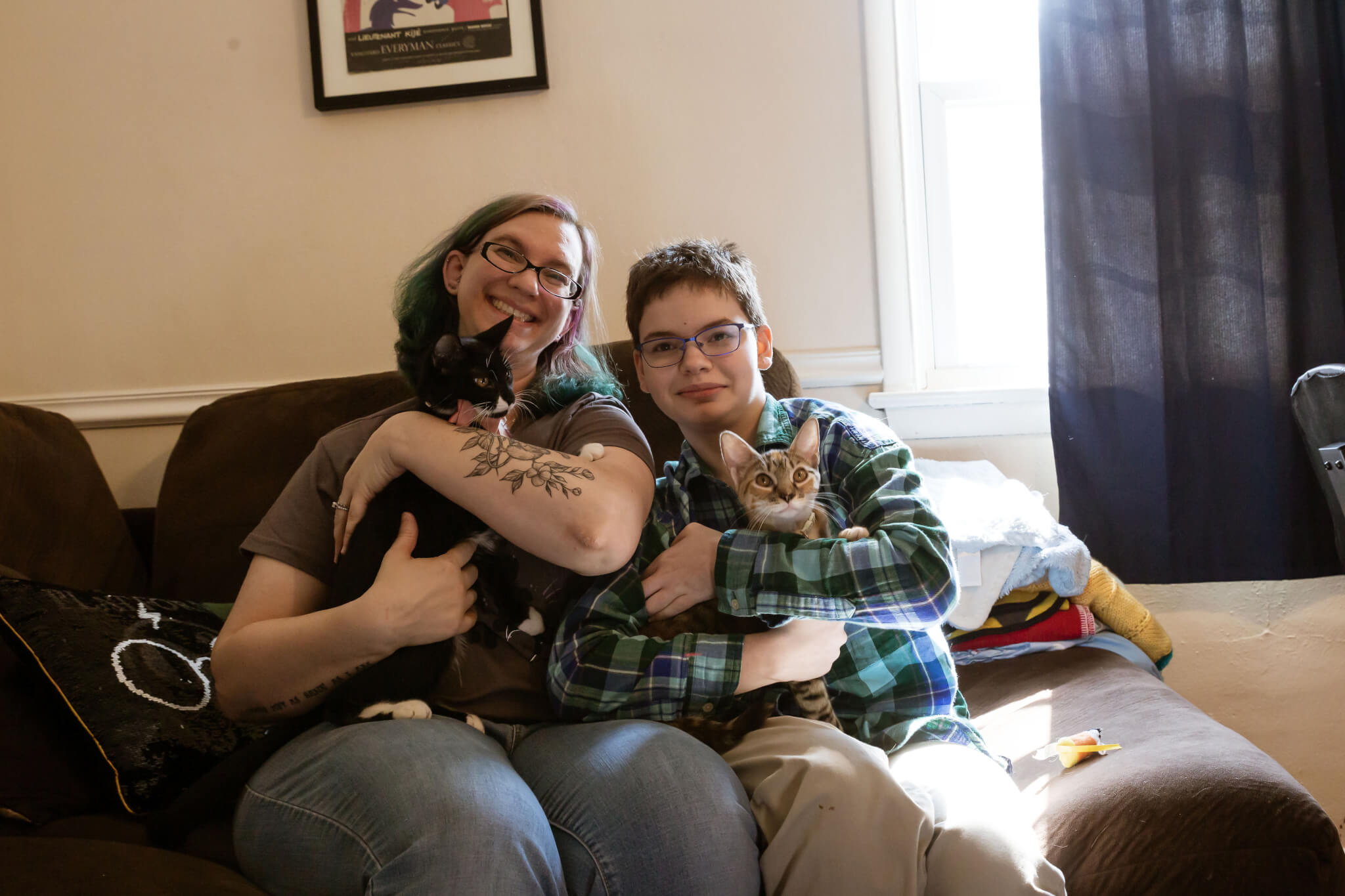

September 2020 Volunteer Spotlight — Marian Childress
This month we would like to spotlight the late Marian Childress, a dedicated animal welfare advocate and endangered species conservationist who passed away on August 23rd, 2020. Marian volunteered with the Virginia Beach SPCA for many years, and she was the compassionate force behind the VBSPCA Canister Program – a program that places change canisters in local businesses to collect donations for the animals. She and her husband ran this program for 28 years and together they raised over $169,000 for the VBSPCA.
 Marian remains a shining example of volunteerism at its best. She believed in the canister program from the beginning, and she built long-standing partnerships with many local businesses. Marian and her husband recognized the critical role that fundraising plays at the VBSPCA, so instead of relying on coin counting machines to count the donations, they counted every single coin by hand! This ensured that thousands of dollars that would have gone to fees instead went to the animals of the VBSPCA.
Marian remains a shining example of volunteerism at its best. She believed in the canister program from the beginning, and she built long-standing partnerships with many local businesses. Marian and her husband recognized the critical role that fundraising plays at the VBSPCA, so instead of relying on coin counting machines to count the donations, they counted every single coin by hand! This ensured that thousands of dollars that would have gone to fees instead went to the animals of the VBSPCA.
All of us at the VBSPCA are incredibly grateful for Marian’s service to the animals and for the lasting impact she has made on our organization. Her sweet spirit will be missed throughout our community as she was an inspiration to everyone she met. Our canister program will continue on, as she hoped it would, but from this point forward it will be in her honor.
If you would like to have a canister placed in your business, please email volunteer@vbspca.com.
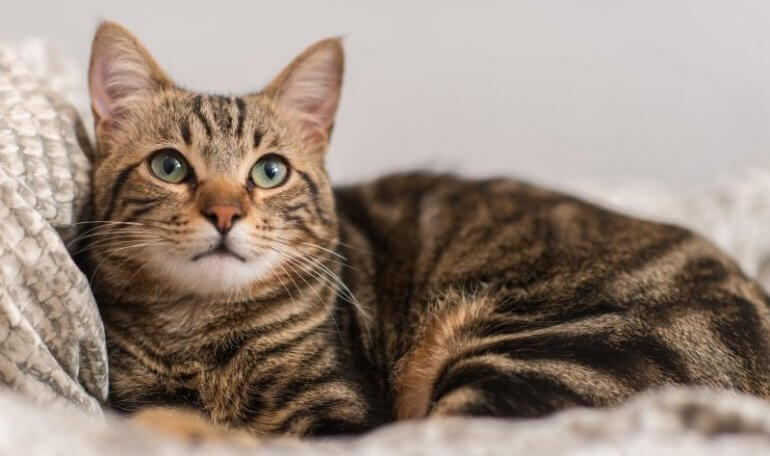
Cats Need Claws
Scratching is a natural and necessary behavior for cats. This behavior keeps nails and paws healthy while also stretching the body and working off excess energy. Additionally, when cats scratch an object, scent glands on the paws help establish a presence in the home, improving confidence and enhancing the feeling of comfort in the physical surroundings.
However, as much as this behavior may be necessary for a cat’s health and wellbeing, no one can deny that scratching can be destructive to the home. Scratching is one of the most common complaints from cat owners, and the first step in dealing with the unwanted behavior is understanding that scratching is a necessary piece of a cat’s wellbeing. Instead of discouraging the behavior altogether, the healthy alternative is to drive the scratching towards an option that won’t destroy the home. Read below for some helpful tips on how to encourage healthy scratching:
Scratching Posts
The best option is to use scratching tools. Place scratching posts or scratching boards in areas where you spend a lot of time. This way, your cat can create a presence in the home and positively share your favorite spaces with you. If you notice your cat continues to scratch in an unwanted area, work with that knowledge and offer a positive scratching option next to or near the established scratching spot.
Types of Scratchers
It’s important to have both vertical and horizontal scratching surfaces. Scratchers should be tall and long so your cat can stretch all the way out before pulling down/back on the surface. As for what type of cat scratcher material to use, it’s can be helpful to choose a material that is different from other items in your home. For example, if you don’t want your cat to scratch on the carpet, then don’t get scratchers covered in carpeting. This will help to reduce scratching on unwanted surfaces in the future.
No-Yes
You can also try the “No-Yes” method, which reinforces where the scratching is unwanted while providing a positive replacement location. For example, double-sided tape has an unwanted texture that causes an adverse reaction when your cat tries to scratch it. If you place the tape on the unwanted scratching spot and put a scratcher right next to it, this reinforces the “no” while redirecting the scratching to an accepted space, the “yes.” There are other textures and methods to reinforce the “no,” but double-sided tape is easy to find, inexpensive, and some brands are designed specifically to prevent scratching and are safe on fabric. You can even add extra enticement by sprinkling or spraying catnip on the scratcher.
In addition to scratching options, having a “cat-only” zone can help, too, as it offers your cat the option of a private space to retreat to when feeling moody, instead of resorting to defensive scratching. Also make sure you regularly trim your cat’s nails. This will prevent accidental scratches and snags which can trigger further scratching. Another option to consider is the use of nail coverings, which are available at most pet retail locations. You can apply nail caps to your cat’s nails yourself and they last around 4 to 6 weeks. As you can see, there are a variety of options that can help remedy unwanted cat scratching, but whatever you choose to do, DO NOT declaw your cat.
Declawing
Dr. Ann Marie Woyma, Virginia Beach SPCA’s Medical Director, explains that in order to actually prevent the nail from growing back, which is the purpose of the declawing procedure, you must remove at least half of the joint. This means declawing is bone surgery, not a nail trim. This procedure is similar to amputating every fingertip on a human hand. As the body heals, the scar tissue that forms can cause arthritis in a cat’s joints while also negatively impacting the scent glands in the paws. Since the scent glands can no longer be used appropriately, a declawed cat cannot establish a presence in the home which can lead to mental and emotional issues.
Paw sensitivity is another concern, and kitty litter may begin to irritate a cat’s paws. This irritation can lead to a negative association with using the litter box. Additionally, declawing a cat can impact a cat’s ability to positively interact with other animals and people. Declawed cats have lost a natural form of communication, so they are less likely to get along with other pets. They feel more vulnerable, so they are more likely to use biting a defense since they can no longer use a warning swat. Bottom line: the surgery puts an animal through unnecessary pain and trauma while also resulting in mental, emotional, and behavioral issues.
Declawing has become such an ethical issue that many countries that have already banned declawing procedures. The surgery is against the law in the United Kingdom, much of the European Union, Australia, and at least 10 other countries around the world. While declawing is not yet banned in all of the United States, at least five states currently have or are in the process of creating anti-declaw legislation.
The Virginia Beach SPCA does not condone declawing. All feline adopters sign a written statement agreeing that they will not declaw any cat adopted from our shelter. 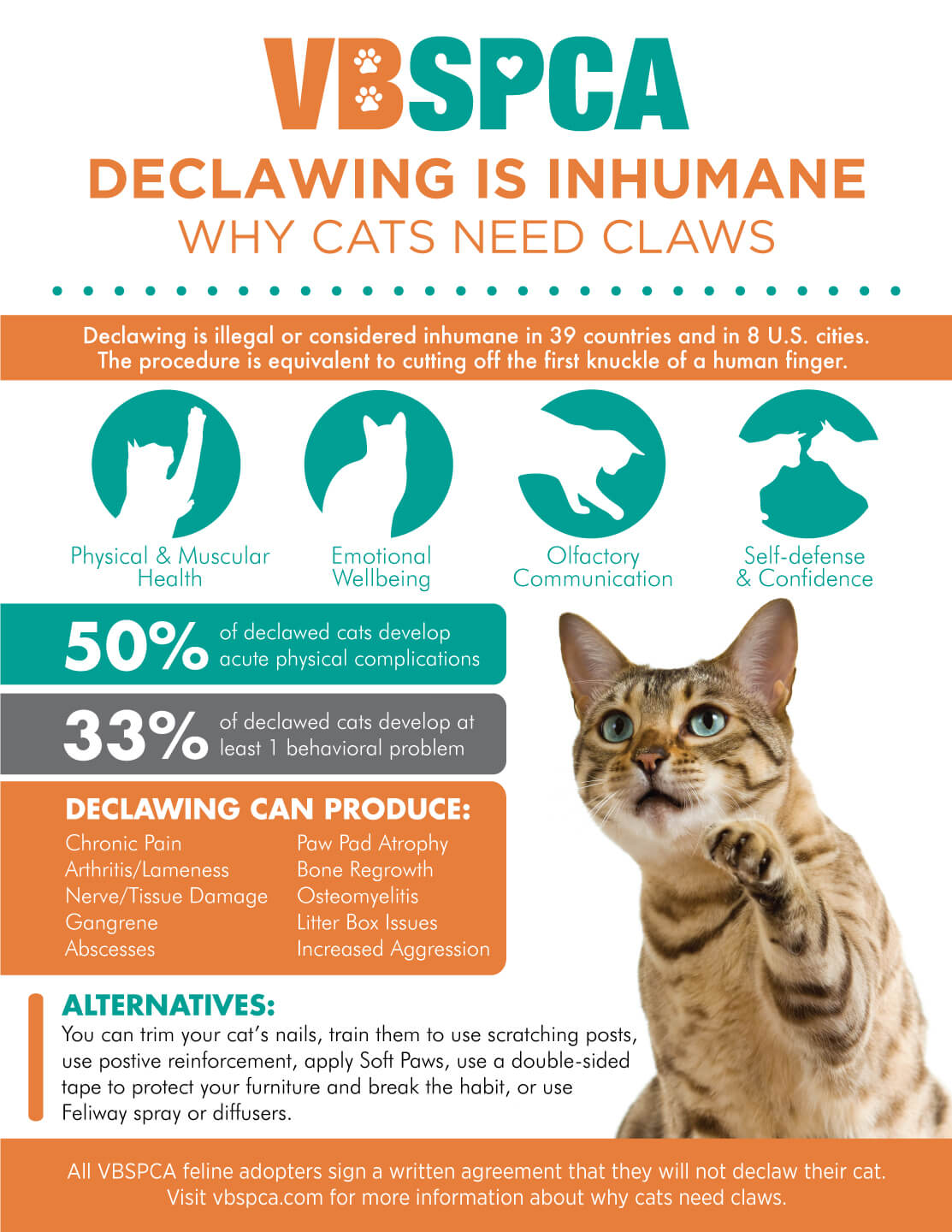

Happy Tails — Holly Berry
Every single animal that comes through our shelter has a story. Some are complex, many are sad, but all of them get better the minute they arrive at the Virginia Beach SPCA. Holly Berry was transferred to our shelter after our friends at PETA saved her from life on a chain. She captured the heart of her adopted mom Corinne and the rest is history. Since adoption, Holly Berry has inspired a tethering bill and has helped other dogs with similar pasts regain their confidence. Read more below on Holly Berry’s story and how she is doing in her forever home!
What is Holly Berry’s adoption story and why did you choose her?
I had briefly met Holly after she was transferred from PETA and then again during her rehab period, and knew that she was a really sweet dog but in really bad shape. If you look at pictures of her from then, it’s hard to believe she made it. After meeting with Holly Berry again and then in another session with my other dogs, I knew she was meant to be part of our family. What is unique about this story is that my husband Loren was deployed to Antarctica during this time. I really thought I was going to have to work hard to get him onboard because we weren’t in the market for another pet. However, his two line reply email to my three page persuasive argument simply stated that he knew we were getting her the day I brought her up months before. Clearly, I married the right guy.
Tell us a little about the bill she inspired! Has it passed or what can people do to get involved?
Holly Berry has become the face of what can happen when an animal is given a second chance in a loving family, and the absolute power of community coming together to care and speak for those who don’t have a voice of their own. On February 10th, 2020, SB 272 or the “Holly Berry Bill” passed in the Virginia Senate and is in the queue at the Virginia House. SB 272 is a state-wide bill that sets stricter parameters of outdoor tethering, increases certain minimum tether length requirements, and the proper sheltering of animals in extreme temperatures and weather advisory scenarios. I encourage anyone who considers themselves an animal lover or advocate to read the bill and rally their elected officials to support it by whatever means they feel inclined and motivated to do so.
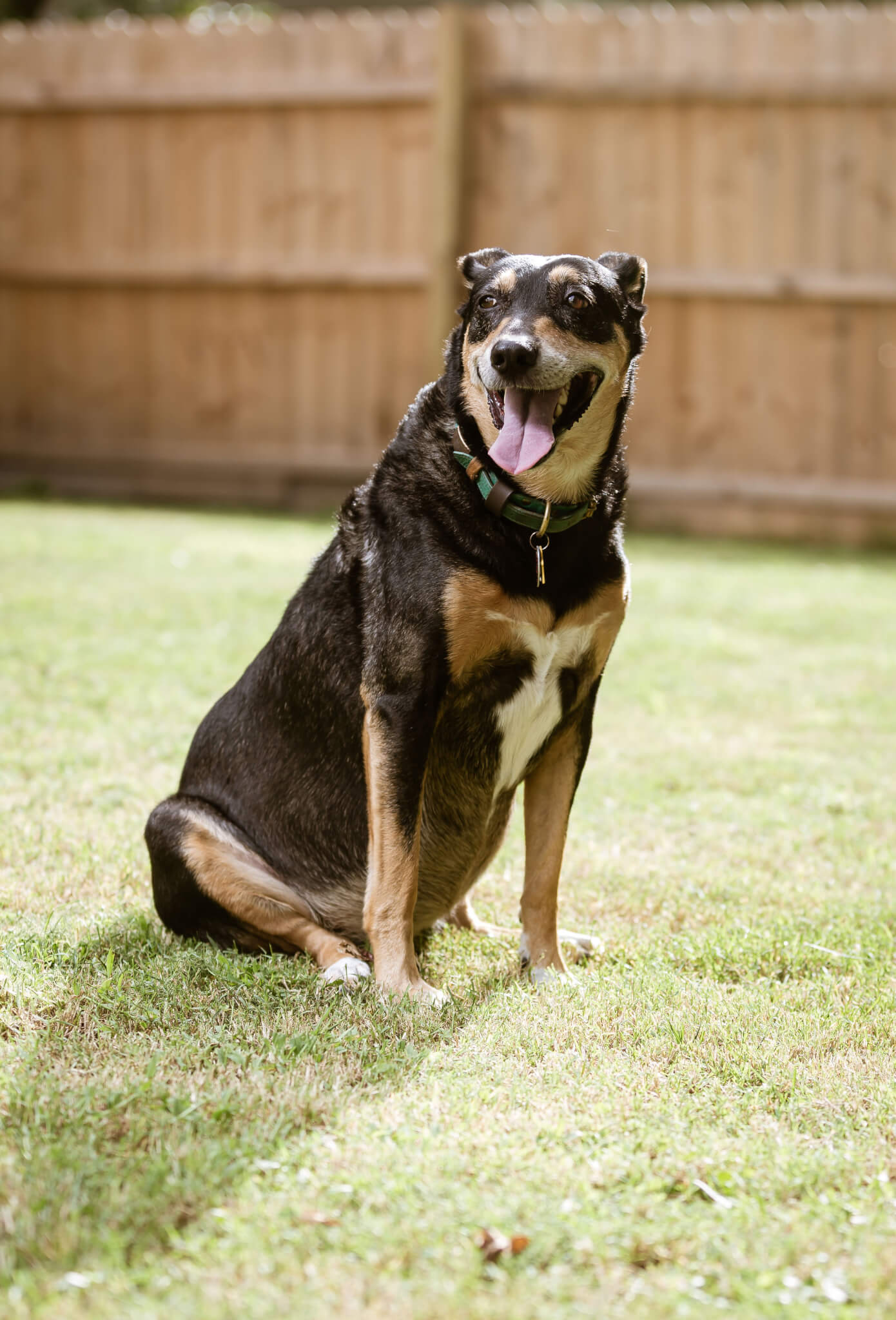
How has she been doing in your home?
Holly Berry has thrived as being part of what we call the ‘band of beasts’, and has become the dog that I knew she could be. Her natural draw and empathetic nature towards anyone in distress is something I’ve never seen before; she’s definitely an empath. She is such a mother figure to babies, children and puppies. She has been instrumental in us successfully fostering dogs who have come from similar circumstances that we’ve brought into our home to teach them how to be confident. She really is one of a kind and we are so fortunate to be the ones to give her the life she always deserved.
Why should people adopt from animal shelters?
Some shelter animals have been put through the worst of what humans can do to another living creature; Holly Berry was one of them and she wouldn’t have made it if it weren’t for the unbelievable passion and work of the dedicated VBSPCA team. I’m assuming everyone has been in a situation where they have been given a second chance at one time or another in their life, and that is what adopting a shelter animal is. You are giving that animal a second lease on life.

August 2020 Volunteer Spotlight — Gretchen & Kelsie
Community support is the lifeblood of our organization. Donations of time and dollars provide the essential support that keeps our many programs running, ensuring continued care for the animals who need our help. Gratitude is at the center of all our interactions, and this month we would like to shine our Volunteer Spotlight on the individuals who make our expressions of gratitude so meaningful.
When someone donates to our shelter for the first time, we send out a handwritten thank you card to give a tangible reminder of the impact donations have on our organization. Some of our passionate volunteers cannot help out in person at our shelter, so they assist us in writing our first-time donor thank you cards. We caught up with a couple of these volunteers and asked them about their experience helping out the VBSPCA.
Volunteer Gretchen started helping during the first phase of the COVID-19 lockdown due to the volunteer program temporarily shutting down. She says that she appreciates being able to volunteer in such a meaningful way.
“I signed up to be a volunteer right before the COVID lockdown. Even though there has been some opening back up, I’m unable to come into the VBSPCA in person. Writing notes seems like a small effort but I know how important it is to recognize our donors. I’m just happy to help in any way I can!”
Kelsie donated to the VBSPCA and was so impacted by the thank you card she received that she immediately reached out to see if she could help.
“I remember receiving a handwritten note from the VBSPCA after I made my first donation and thinking how thoughtful it was that someone took the time out of their day to write it. It really brought to light how much even my small donation meant to the entire organization so it’s been fun to now be on the other side of the cards. Writing out thank you cards is a small task in the scheme of volunteer duties, but I think it’s an important gesture for the donors and I’m grateful to be able to contribute.”
We are greatly appreciative of all the support we receive from our volunteers to help thank our donors, especially at this place where the donation of time and dollars intersect. Gretchen and Kelsie are just two examples of the many volunteers who assist us in this way and we are so appreciate the time and energy they donate to the mission of the VBSPCA.
If you would like to volunteer to write thank you cards or help with another opportunity, please email volunteer@vbspca.com.
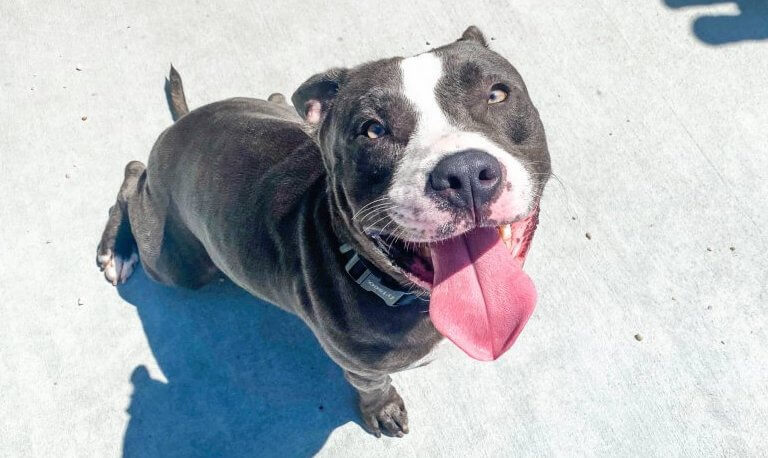
Keep Pets Cool — Heat and Hydration Safety Tips
Warm weather means beautiful greenery and extended time outdoors. However, heat can also be incredibly dangerous to our four-legged friends. Imagine wearing a fur coat during a trip to the beach! Below are some helpful tips on how to keep your pets cool and hydrated.
Safety Tips:
Find Shade
If you and your pet are outside during the day, make sure to allow your pet plenty of time in the shade. You can also provide your dogs with a kiddie pool filled with cool water or a cool towel to lay on.
Protect Their Paws
When taking your pet for a walk, check the pavement with your hand before you leave. If you can’t leave your hand for longer than 3 seconds, it is too hot for your pet! Go for walks in the morning or evening when it’s cooler. If you must take your pet out during the day, allow them to walk in the grass.
Hydration is Key
Pets can get dehydrated quickly, so be sure to provide them with plenty of fresh, cool water. Add some ice cubes for extra fun! If you and your pet will be outside for more than 5 minutes, bring water and a bowl with you.
Know the Signs of Heat Stroke
Animals pant to cool down their body, but if the humidity is too high, animals can’t get cool. Watch for heavy panting, excessive water consumption, and signs of disorientation. Lower their temperature by wetting the top of their head with cool water and increase air movement with a fan. Consult with the pet’s veterinarian as soon as possible.
Pets in Cars
Cars have the same effect as ovens when turned off. Never leave your pet in your car, especially during hot weather. Check out the thermometer below to see just how hot the inside of cars can be.
Hydration:
One important factor of your pet’s health is hydration, but what many pet parents do not realize is how quickly pets can become dehydrated. Below are some things to keep in mind during warm weather:
Understand how much water your pet needs. Water consumption is important for all mammals, but it is especially important for dogs and cats. Your pet’s body is made up of 80 percent water, which means your pets constantly have to drink water in order to stay well hydrated. On average, your pet needs one ounce of water for every pound that they weigh. If they are exercising or going outside, they may need more.
Avoid going too long without water. A good general rule is to always have access to fresh water no matter where you are. One great product that we recommend is the OllyBottle that acts as both a water bottle and water bowl for your dog!
Know the signs of dehydration. Dehydration can happen very quickly. Know the signs to make sure you can get your pet help as soon as possible:
- Vomiting and/or diarrhea
- Loss of energy
- Excessive, ongoing panting
- Loss of appetite
- Sunken, dry eyes
- Dry, sticky gums
- Loss of skin elasticity
What to do. If you notice signs of dehydration in your pet, contact your veterinarian immediately.
Heatstroke:
Dogs cool themselves down by panting. However, during extremely hot weather, sometimes a dog’s body temperature rises too high and causes heatstroke. Prevention is extremely important, but if you suspect your dog is suffering from heatstroke, take them to receive veterinary care immediately.
What is heatstroke? Heatstroke is a type of hyperthermia that happens when a dog’s panting cannot accommodate excessive heat.
Understand your surroundings. If you are sweating or feel overwhelmed by the heat, your dog does too! Your furry friend will always try to push themselves to please you. Make sure you are not asking them to exercise or be in an environment that will increase their chances of heatstroke.
Know your dog’s limits. Dogs with shorter snouts or longer hair may be more susceptible to heat exhaustion. Understand your dog’s potential needs and compromise to keep your pet safe.
Do not use ice cubes to cure heatstroke. When trying to cool your pet down, you must slowly decrease their temperature to prevent complications. Ice cubes are great in a dog’s water bowl on a hot day, but if they are already suffering from heatstroke, very cold water or ice cubes can cause shock. Cool towels are best to start bringing the fever down.
Preventing health issues before they occur helps both you and your pet enjoy fun in the sun. If you would like to have a fun reminder of tips, print out the helpful infographic below!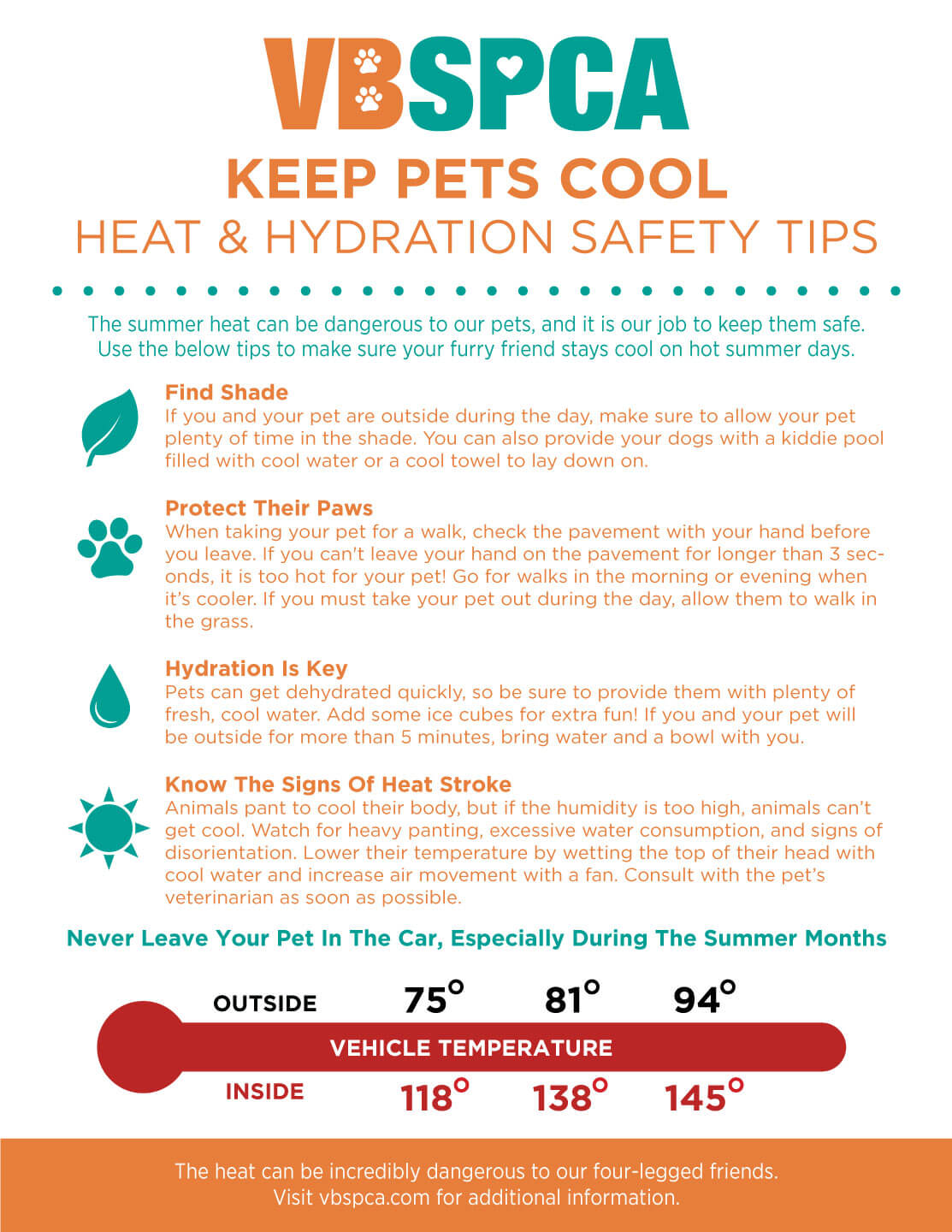
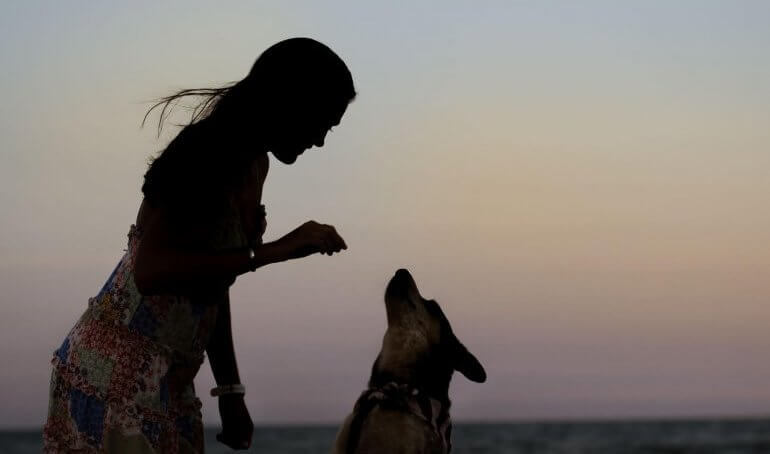
Happy Tails — Salty
Every single animal that comes through our shelter has a story. Some are complex, many are sad, but all of them get better the minute they arrive at the Virginia Beach SPCA. Grit was brought to the shelter in 2020 when his human lost their job because of the COVID-19 pandemic. He didn’t have to wait long for a new family to come along and give him a great home. We recently caught up with his mom Brooke, and she gave us an update on Grit and their adventurous life together.
What is Grit’s adoption story?
Grit was shy and sweet when we met him at the shelter. He was shaking and scared but finally warmed up to us. After about 15 minutes of meeting him, we knew he would fit in with our family. He was very anxious and scared at the shelter but found comfort with us. He fell asleep on my leg in the car with a sweet smile on his face. We took him home the day before Easter and he was our Easter bunny! We were so happy to have Grit on Easter because no one else could visit because of the coronavirus pandemic.
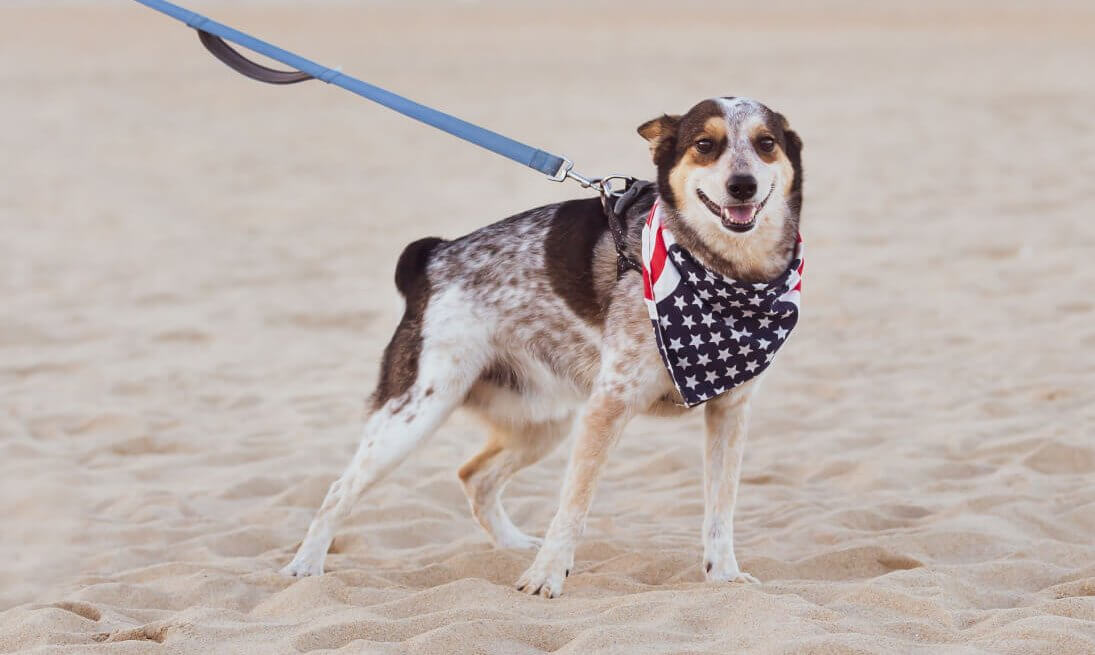
How has life with Grit been since his adoption?
Grit is much happier and has more personality. We love to walk him to the beach and through the park. Our good friend is a dog trainer and has helped us with tips and tricks. He will do anything for a treat!
Any cute quirks or funny stories you would like to share?
Grit loves food. He’s very quick and sneaky when it comes to snatching food so we have to watch him very closely. He will do anything for a treat, so it’s fun to teach him new tricks!
Grit has an active Instagram account, what inspired you to document his adventures?
It’s so fun to record his antics and funny faces, so it was natural to start posting him. He’s a very expressive dog with eyebrows and ears that move a lot to show his feelings. Grit almost looks like a cartoon sometimes! He’s active on instagram @gritthesaltydog and was inspired by his cousin @oldtownluna. They are both rescue dogs and love showing off their adventures.
Unfortunately many animals, including Grit, lost their homes due to the COVID-19 pandemic. Why is it important to adopt during this time?
Every pet deserves a loving home and it is so sad when someone hits hard times and can no longer keep their pet. We feel so sorry for families that have to give up their pets during this time, but we are so grateful that shelters like the VBSPCA can help them through the process. Grit has brought our house so much happiness during these difficult times, and if you are able, I definitely recommend welcoming a pet into your home during this time!

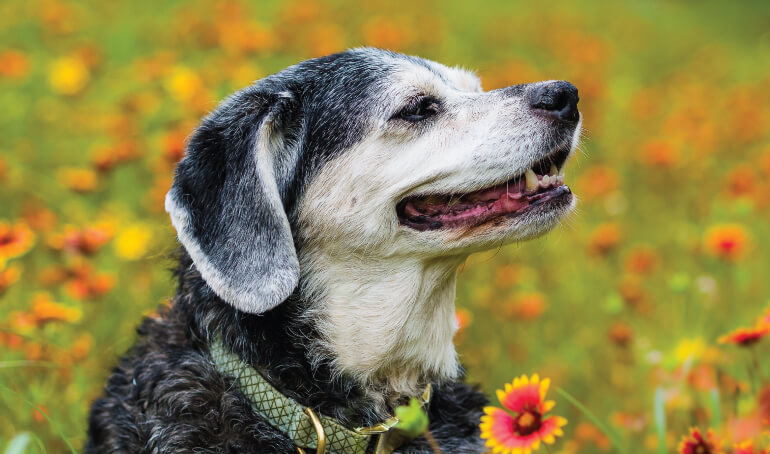
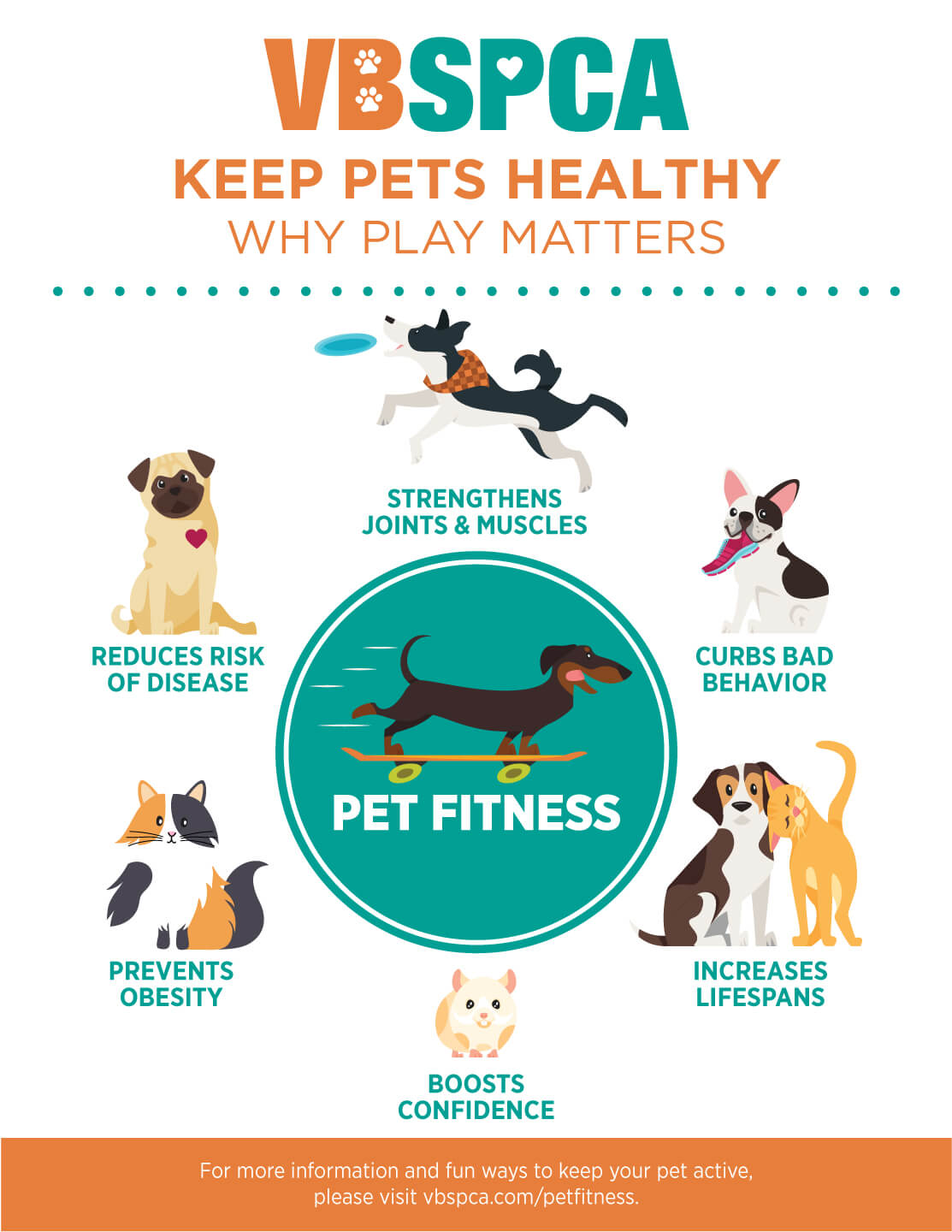





















Last Updated: June 1, 2022 by vbspcaadmin
Why Senior Pets Make Great Companions
Senior pets make great pets! A dog or cat is considered a senior if they are seven years or older. If you are considering adopting a furry family member, here are some reasons to consider welcoming an older pet into your home:
Senior pets are often long term shelter residents. Seniors often struggle to catch the eye of an adopter, as puppies and kittens are more appealing to many. Adopting a senior is an extra gesture of kindness.
Age is just a number. Dogs and cats live for 10-15 years on average, and many live even longer than that. A “senior” pet has lots of love left to give, and many special memories are yet to be made.
Train less, enjoy more. Most adult dogs are already house-trained so you won’t have to go through the difficult stages of teaching house manners and cleaning up after accidents. Also, your shoes are probably safe since they are out of the puppy chewing stage.
Easier Introductions. Senior pets are often on the mellower side, and they can be easier to introduce to resident pets. They are also known to settle into new environments with a bit more ease.
Health problems can arise at any age. Some adopters are concerned about the health issues and expenses that can come with an older animal, but the reality is that health issues can arise at any age. When adopting an older animal, you have a better idea of what to expect, especially when adopting from the VBSPCA. All VBSPCA seniors have special bloodwork done before adoption to make sure adopters are prepared with the information they need.
It makes you feel good! You can be a hero to a deserving animal. Almost without exception, people who adopt older animals feel a special sense of pride and purpose in opening their heart to a harder-to-adopt pet. Doing a good thing really does make you feel good!
It takes a special person to adopt a pet knowing you may have a shorter amount of time together than you’d like, but adopting a senior pet is the the ultimate gift of generosity. Next time you think about welcoming a new pet into your home, consider the older animals who are just as deserving of a forever family. You’ll be the love of their life. It’s worth it.
To view our adoptable animals, click here.